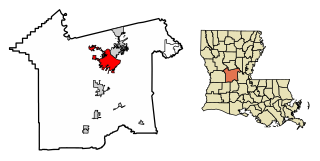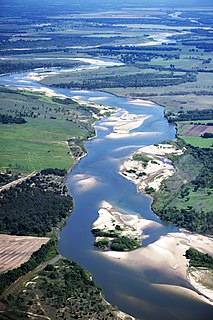
Natchitoches is a small city and the parish seat of Natchitoches Parish, Louisiana, United States. Established in 1714 by Louis Juchereau de St. Denis as part of French Louisiana, the community was named after the indigenous Natchitoches people.
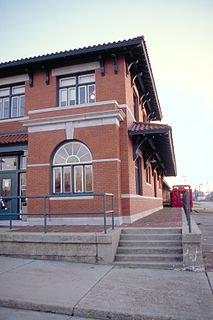
The Delta Cultural Center in downtown Helena, Arkansas, is a cultural center and museum of the Department of Arkansas Heritage. It is dedicated to preserving and interpreting the culture of the Arkansas Delta.

Historic Washington State Park is a 101-acre (41 ha) Arkansas state park in Hemsptead County, Arkansas in the United States. The museum village contains a collection of pioneer artifacts from the town of Washington, Arkansas, which is a former pioneer settlement along the Southwest Trail. Walking interpretive tours are available throughout the 54 buildings. Washington served as a major trading point along the Southwest Trail, evolving into the Hempstead county seat and later the capital of Arkansas from 1863 to 1865 when Little Rock was threatened during the Civil War. The original plat of Washington was added to the National Register of Historic Places in 1972 as the Washington Historic District.

Carrollton is a historic neighborhood of Uptown New Orleans, Louisiana, USA, which includes the Carrollton Historic District, recognized by the HISTORIC DISTRICT LANDMARK COMMISSION. It is the part of Uptown New Orleans farthest upriver while still being easily accessible to the French Quarter. It was historically a separate town, laid out in 1833 and incorporated on March 10, 1845. Carrollton was annexed by New Orleans in 1874, but it has long retained some elements of distinct identity.

The New Orleans Mint operated in New Orleans, Louisiana, as a branch mint of the United States Mint from 1838 to 1861 and from 1879 to 1909. During its years of operation, it produced over 427 million gold and silver coins of nearly every American denomination, with a total face value of over US$ 307 million. It was closed during most of the American Civil War and Reconstruction.
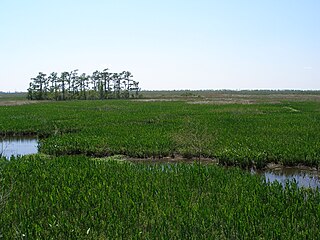
Jean Lafitte National Historical Park and Preserve protects significant examples of the rich natural and cultural resources of Louisiana's Mississippi River Delta region. The park, named after the pirate Jean Lafitte, also interprets the influence of environment and history on the development of the unique Cajun regional culture. The park consists of six physically separate sites and a park headquarters.
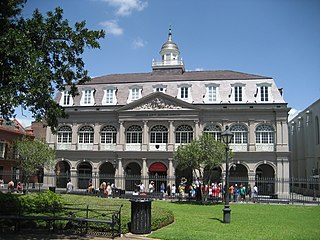
The Cabildo was the seat of Spanish colonial city hall of New Orleans, Louisiana, and is now the Louisiana State Museum Cabildo. It is located along Jackson Square, adjacent to St. Louis Cathedral.

Jackson Square is a historic park in the French Quarter of New Orleans, Louisiana. It was declared a National Historic Landmark in 1960, for its central role in the city's history, and as the site where in 1803 Louisiana was made United States territory pursuant to the Louisiana Purchase. In 2012 the American Planning Association designated Jackson Square as one of America's Great Public Spaces.

The Old Louisiana State Capitol, also known as the State House, is a historic government building, and now a museum, at 100 North Boulevard in Baton Rouge, Louisiana, U.S.A.. Built in which housed the Louisiana State Legislature from the mid-19th century until the current capitol tower building was constructed in 1929-32.
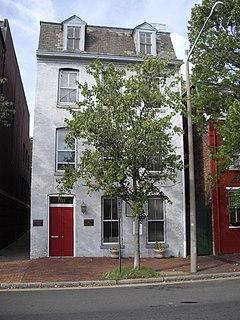
The Franklin and Armfield Office, which houses the Freedom House Museum, is a historic commercial building at 1315 Duke Street in Alexandria, Virginia. Built c. 1810-20, it was first used as a private residence before being converted to the offices of the largest slave trading firm in the United States, started in 1828 by Isaac Franklin and John Armfield. "As many as [a] million people are thought to have passed through between 1828 and 1861, on their way to bondage in Mississippi and Louisiana". Another source, using ship manifests in the National Archives, gives the number as "at least 5,000". One million is generally historians' estimate of the total of all slaves who were moved to the Deep South in the domestic slave trade.
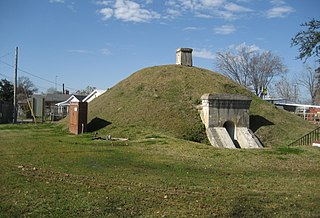
Camp Parapet was a Civil War fortification at Shrewsbury, Jefferson Parish, Louisiana, a bit more than a mile upriver from the current city limits of New Orleans.

Melrose Plantation, also known as Yucca Plantation, is a National Historic Landmark in Natchitoches Parish in north central Louisiana. This is one of the largest plantations in the United States built by and for free blacks. The land was granted to Louis Metoyer, who had the "Big House" built beginning about 1832. He was a son of Marie Therese Coincoin, a former slave who became a wealthy businesswoman in the area, and Claude Thomas Pierre Métoyer. The house was completed in 1833 after Louis' death by his son Jean Baptiste Louis Metoyer. The Metoyers were free people of color for four generations before the American Civil War.

Jackson Barracks is the headquarters of the Louisiana National Guard. It is located in the Lower 9th Ward of New Orleans, Louisiana. The base was established in 1834 and was originally known as New Orleans Barracks. On July 7, 1866, it was renamed in honor of Andrew Jackson. The National Register of Historic Places listed Jackson Barracks in 1976.

The Whitney Plantation Historic District is a museum devoted to slavery in the Southern United States. The district, including the main house and outbuildings, is preserved near Wallace, in St. John the Baptist Parish, Louisiana, on the River Road along the Mississippi River. The plantation was started in 1752 by German immigrants Ambroise Haydel and his wife, and their descendants owned it until 1867.

Louisiana African American Heritage Trail is a cultural heritage trail with 26 sites designated in 2008 by the state of Louisiana, from New Orleans along the Mississippi River to Baton Rouge and Shreveport, with sites in small towns and plantations also included. In New Orleans several sites are within a walking area. Auto travel is required to reach sites outside the city.

The following outline is provided as an overview of and topical guide to the U.S. state of Louisiana:

The Lyceum is a historic structure in Alexandria, Virginia. It was built in 1839 and has been listed on the National Register of Historic Places since May 27, 1969. It was built, from bricks from the original St. Mary chapel, as a permanent home for the Alexandria Lyceum and the Alexandria Library. It served as a hospital during the American Civil War. After the war it became a private home and later served as an office building. Today it is the location of thee official city history museum of Alexandria.

Mansfield State Historic Site, formerly known as Mansfield Battle Park, is a Louisiana state historic site which preserves the site of the 1864 Battle of Mansfield in the American Civil War. It is located four miles south of Mansfield, the seat of DeSoto Parish in northwestern Louisiana. The battle is considered significant because Confederate troops succeeded in the overall Red River Campaign in turning back large Union forces, preventing the progression of the war into Texas, and perhaps delaying the final southern surrender on April 9, 1865.
Elsie Elizabeth McLundie Bolton, known as Peggy Bolton, was a civic and cultural figure in Alexandria, Louisiana, particularly known for her devotion to historical preservation and the arts.




